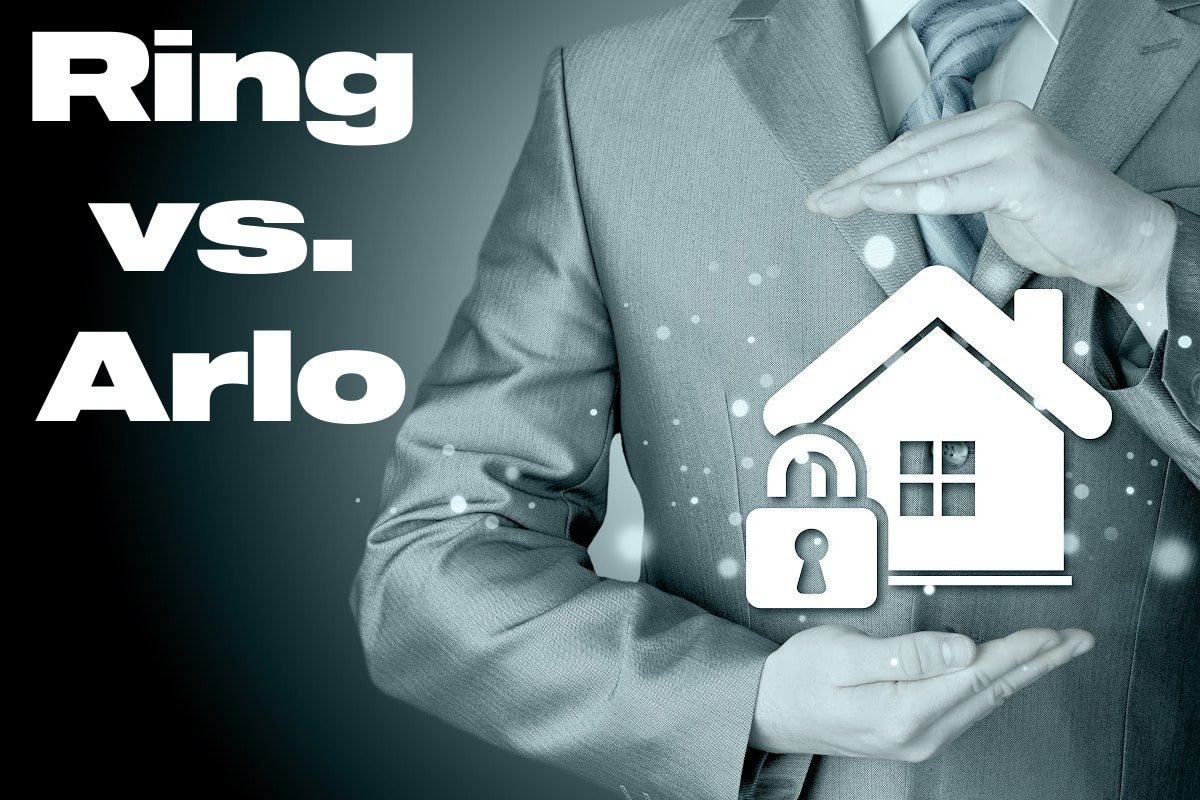DIY home security. Nowadays, it’s impossible to drive down any street and not see a Ring doorbell camera or something really similar. These DIY home security systems are very popular and the market grows every year. In fact, the home security systems market will be an $84 billion market by 2027. Most people are looking for a DIY home security system that will keep their family safe. Don’t necessarily want a ton of bells and whistles, but want effective home monitoring. We wanted to compare the Ring Alarm vs Arlo Pro home security systems to help you decide which one is right for you. Both of these systems are popular DIY security options, but they have some slight key differences that you need to know about before making your decision.
Arlo vs Ring Comparison
We all know home security is important for keeping your home and family safe. There are many different home security systems on the market, some high-end professional grade, and a ton of DIY options. But two of the most popular are Arlo home security and Ring home security. Both systems offer a variety of features to help keep your home and property secure. For example, both Arlo and Ring offer motion-activated cameras that can record video and send alerts to your phone if someone enters your home. Both systems offer doorbell cameras that allow you to see who is at your door and speak to them through your smartphone. Finally, both systems come with a base station that helps to connect all of your devices and allows you to control them from one central location. While there are some differences between Arlo and Ring home security, both offer a great DYI option for keeping your property and home safe.
DISCOVER: Home Automation? What Is That? We Answer That And More!
Some other similarities between the two:
- Arlo and Ring are DIY friendly
- Term-free (you don’t have to get roped into multiple-year contracts just to use the hardware)
- Wireless surveillance
- Feature-rich and reasonably priced
- Both are extremely easy to set up and install
- Both have easy-to-use apps to make home monitoring enjoyable
Arlo vs Ring: How They Differ
Although both of these systems are very similar in purpose, there are some subtle differences.
- Arlo acts more like a surveillance system, while Ring acts and behaves more like a home security system. Arlo’s secure plan feels more like an ADT system, but DIY.
- Arlo’s cameras slightly outperform Ring’s
- In terms of setup and installation, most novice tech users are going to be able to set up Ring in about half the time vs Arlo.
Ring vs Arlo: Quick Installation
A significant strength of Ring is its DIY installation. You don’t need to drill a ton of holes or splice wires. I didn’t need help, but I did check out the tutorials, and Ring’s help center is there and effective. I thought the install guides were a little easier to follow vs Arlo’s. But not by much. Both brands had customer support ready to help in case of trouble-shooting during the installation.
Depending on the system and package, Arlo takes less than 2 hours to set up. Don’t mistake time for difficulty. Arlo is still easy installation. It has mountable cameras (spotlight). You’ll need at least an hour or two for Arlo’s setup. And just Ring, Arlo’s Support Center helps you on the go and is very helpful.
Overall, both Arlo and Ring offer ready-to-use security systems where users can quickly plug and play. No hassles, but if you do run into some (and that’s okay), you’ll have customer support. Simply put, both are impeccable when it comes to easy and fast home security installation.
Winner: Ring Home Security
Ring vs Arlo: Connectivity
Both home security systems have wireless setups, which is an absolute deal-breaker if you are doing DIY home security. Having used both apps for monitoring, there isn’t a clear-cut winner on who has the best app. Both perform and operate really well. The one advantage Ring has in the app department of connectivity is the Neighbors app feature. I love the up-to-date crime notifications and video footage around my community.
LEARN MORE: Ring Video Doorbell Tips And Tricks
On the other hand, I love how Arlo connects with Alexa, Google Assistant, Apple HomeKit, and Samsung SmartThings flawlessly. Ring does work with these smart home automation assistants, but for some (like Apple HomeKit) you’ll need to use a home bridge hub or device, which isn’t difficult to do… but’s just one more thing to work around.
Winner: Tie
Ring vs Arlo: Design And Durability
Security equipment quality at Ring is top-notch. The Ring is Amazon’s brand, so the resources to get it right are endless. It comes in different colors and the tech (hardware included) is simple. Unboxing the product shows solid construction. At first feel, it seems like Ring’s product lack quality standards, but the equipment is solid and durable for its price. I still have my first-generation Ring doorbell camera and it still works flawlessly.
Arlo cameras contain top-notch quality materials. When it comes to weather, the conditions can really affect outdoor cameras. No matter if it’s rain, snow, brutal sun, or sleet, Arlo products keep on delivering.
RELATED: Here’s A Crash Course In Home Automation Basics
Overall, we think Ring offers better quality than Arlo, but that’s because I’ve owned Ring products for years now and they still perform no matter what. That’s not to say Arlo makes a cheap product. On the contrary, Arlo is also made from extremely high-grade materials.
Winner: Slight Advantage to Ring
Ring vs Arlo: Automation (Robotics)
Those who love automation love the Ring. It offers smart doorbells, stick-on, spotlight, and floodlight cameras. The Ring integrates really well with other apps that help you unlock smart home automation. You can automate your home with Z-Wave, Zigbee, IFTTT, and more. Google Home and Alexa can control lights and locks. Ring is one of those products that help make your home smart.
READ MORE: Best IFTTT Home Security Systems
Likewise, Arlo home security devices are super compatible with a handful of smart home devices and home assistant systems. Additionally, Arlo is fast catching up to Ring with automation integrations like IFTTT. I think the community of IFTTT is bigger with Ring, so users get some amazing smart home recipes. BUT…Arlo has some clever smart home integrations as well. For now though…
Winner: Ring
Ring vs Arlo: Support
Ring’s customer support overall is fantastic, but there are those variances when it’s not. When it’s good, it’s great. But there have been some who haven’t had as good of an experience with their customer support and that’s normal. We’re aware of it. I’ve never experienced flawless customer support 100% of the time from a company. Despite its adequate quality, some customers find it impersonal. Besides FAQs and blogs, Ring also provides setup guides and in-store support, which I consider a major part of any company’s customer support plan. Users can contact Ring via live chat, email, or phone. Despite exponential growth, service is still good.
Arlo’s support center is also handy. You’ll find everything online: FAQs, articles, and videos. Even their base package includes 90 days of premium phone support, which I think is wonderful (even if they try to upsell me to their secure plan). Both have an extremely high quality of service. Excellent ratings across the board. Getting support from Ring or Arlo shouldn’t be a problem.
Winner: Tie
Which One Should You Buy?
It’s going to depend on your home monitoring preferences. Both are easy to install. Both are easy to operate. The big difference comes down to what you value with monitoring. If you want strictly video surveillance, Arlo is the solid choice. On the other hand, with Ring, you can get video monitoring PLUS the sensors you put on doors and windows PLUS seamless integration into other smart home automation devices PLUS connection to your community. Personally, I love the ability to upgrade and build on the base level of home security setup you get with Ring. If I’m super green and new to this home security game this is what I’d do: get the Ring video doorbell to get comfortable with DIY home security. Experiment by integrating it into my smart home automation.
Once I feel comfortable, I’d upgrade to the 14-piece kit on all the necessary entry points of my home. Once I’m comfortable with that, then I maybe get the indoor cam or the Ring floodlight cam. As you can see, with Ring you can really customize your home security, which does a few things: allows you to get comfortable with the tech + gives you time to build a robust home security network on your property.








